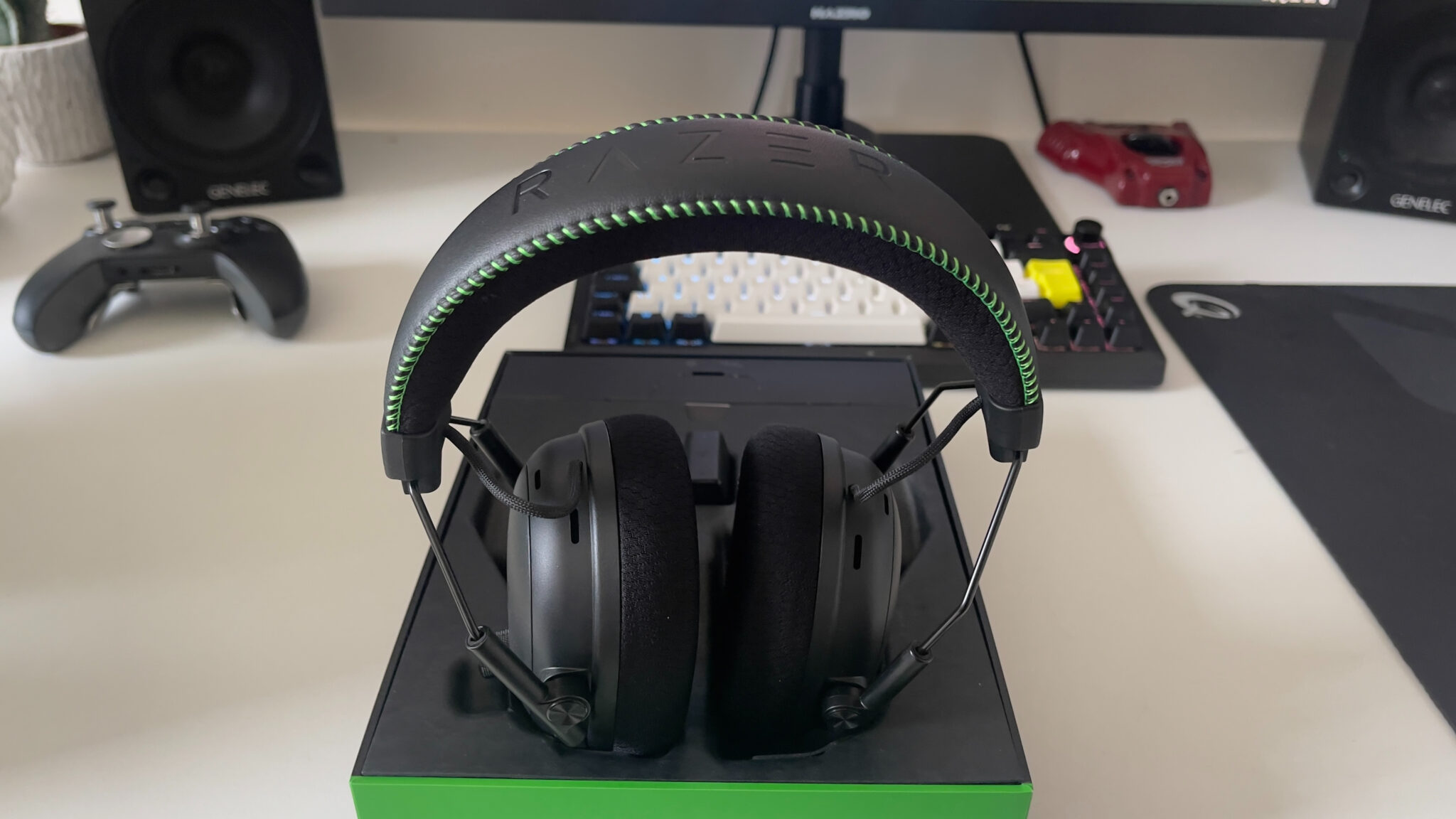Why you can trust TechRadar
We spend hours testing every product or service we review, so you can be sure you’re buying the best. Find out more about how we test.
Razer BlackShark V3 Pro: one-minute review
The Razer BlackShark V3 Pro is, as the keen-eyed will have surmised, an upgrade to the 2024 V2 wireless gaming headset, which adds active noise cancellation to the proposition. Razer’s BlackShark headsets fit into the manufacturer’s range right at the top, in terms of both features and pricing, so the changes it makes to this model are always a real statement of intent.
What is that intent? A combination of one big addition in ANC, plus a few smaller tweaks that demonstrate an open ear to community feedback. It’s odd to see noise cancellation added to a headset that features breathable fabric earcups, since ANC relies on the headset’s ability to isolate sound passively through its physical design in order to work effectively.
In other words, the earcups need to block out maximum ambient sound by creating a vacuum around your ear before the listening technology gets involved. It’s not unheard of, though, as AirPods Max users will attest, and despite the cloth fabric’s inferior isolation properties, these updated BlackSharks do indeed manage to tune out a good deal of unwanted external noise. Best of all, there’s a button on the headset that toggles between ANC on, ambient (using the listening mics to actively amplify external noise), or ANC off.
Those other small tweaks: a slightly redesigned hinge connecting the earcups to the adjustable headband, which is now finished with an aluminum panel and operates slightly more smoothly and – the holy grail of headset features – a physical chat mix scroll wheel, just like SteelSeries adds to their Arctis cans.
Truthfully, there wasn’t much wrong with the existing model, as you’ll see from our Razer BlackShark V2 Pro review. I’ve been using the V2s ever since they released, and I’m delighted that the V3 retains all the strong points like incredible comfort, finish quality, battery life, audio, adds a couple of welcome tweaks, and then slaps in a big value-add like ANC without upsetting the apple cart. The Xbox and PlayStation versions feature very similar offerings, distinguished only by some green headband trim on the Xbox model and a slightly different variant of the dongle.
The only significant downside to using the BlackShark V3 Pro ANC, regardless of platform, is the dongle situation. The supplied HyperSpeed wireless dongle actually requires a USB cable to connect to either a PC or console, while the smaller, neater BlackShark V2 USB-C dongle won’t pair with V3 models. So although the headset’s wireless, the dongle is… wired? That seems like a bit of an odd situation, despite the improved latency that HyperSpeed brings.
Razer BlackShark V3 Pro: Price and availability
- List price: $249.99 / £249.99 / around AU$510
- $50 more than the BlackShark V2
- Considerably cheaper than SteelSeries’ Nova Pro Wireless ANC option
This certainly isn’t a cheap headset. Then again, the BlackShark never has been, and ANC tends to add a considerable price premium on any headset model that offers it, gaming or otherwise.
The cost of blocking out external sound is about $50, versus the outgoing 2024 model of BlackShark V2 Pro, which means anyone considering hitting the buy button has an important question to ask themselves: is ANC essential, or would they be just as happy to use the V2 model instead and enjoy the lion’s share of the same features, for less? V2s sell for less than $180 now and are likely to be discounted further while stocks last.
The other big player in the ANC gaming headset space is SteelSeries, whose Arctis Nova Pro Wireless is among the most feature-rich and lavishly finished models we’ve ever seen. Priced at $349.99 MSRP, it’s a full hundred dollars more expensive than this Razer model, which almost makes the Pro V3 ANC seem like a bargain.
Razer BlackShark V3 Pro: Specs
| Row 0 – Cell 0 |
Razer BlackShark V3 Pro |
|
Price |
$249.99 / £249.99 / around AU$510 |
|
Weight |
367g / 0.81lbs |
|
Battery life |
70 hours |
|
Compatibility |
PC, Xbox Series X|S, PS5 (Xbox version), PC and PS5 (PC/PS5 version), iOS, Android |
|
Connectivity |
Bluetooth, 2.4GHz wireless |
|
Microphone |
16-bit/48KHz |
| Row 7 – Cell 0 | Row 7 – Cell 1 |
Razer BlackShark V3 Pro: Design & features
- Beautifully stealthy looks with immaculate stitching
- All-day comfort, despite the weight
- Great suite of physical controls
BlackSharks are built around an aviation-style headset design, similar to HyperX’s Cloud, which was itself based on the OG QPAD QH90s. That entails two oval-shaped earcups connected not at the top but via a hinge at the side of each to a padded headband.
I’ve been testing headsets for far too many years at this point, and I’ve found this earcup size and design generally offers the best comfort and passive noise cancellation. So when it’s manufactured to a high standard like this and finished with a generous wedge of memory foam, you’ve got a recipe for long-term comfort.
Some people don’t get on with the hinge design. While other headsets offer a notched sensation when you adjust the headband and even show you measurements that you can reference, these BlackShark V3 Pros, like their ancestors, don’t have any of that. Personally, I’ve always found that a bit pointless – surely it’s quicker and easier to adjust until you feel comfortable, rather than dialing in a prescribed number?
It’s true that the thin telescopic aluminum poles that let you adjust for size have traditionally been a bit stiff to operate, and to me it feels like they’re smoother on this model. That could just be the new headset effect, though.
The finish is typically immaculate, as per Razer’s standards. The stitching on the upper leather portion of the headband looks like an Italian sports car’s interior, the imprinted Razer logo running along the top is pin-sharp, and so are the gloss finish Razer logos on the matte earcups. There’s a new aluminium plate on the hinges for these V3s, finished in an engraved spiral design, which breaks up what was previously a plasticky-looking component with a bit of added shine. They probably don’t bring the weight down, but despite its 0.81lbs/367g being towards the heavier end of the market, discomfort isn’t an issue as the headband and earcup cushioning, together with the headset’s clamping force, work together to prevent anything digging in.
I’m such a big fan of the right-hand earcup’s physical controls. Firstly, there’s a button that cycles through three ANC modes: on, off, or ambient, and not even my Bose QC45s offer that much control over ANC, so well done for that, Razer.
Second, I always find a chat mix wheel useful, so its addition to the BlackShark V3 Pro ANC is an extremely welcome one for me. Streamers might like to hear a small amount of their mix audio just to check they’re not muted, and personally, I find it helps to regulate my speaking volume for in-game chat.
There’s also an EQ cycle button, which I never, ever use. Some people might. At least it’s positioned so that I never hit it by accident.
The only significant negative is an enduring one: the supplied HyperSpeed dongle needs a USB cable to be connected to it. The USB-C dongle for the V2 gen won’t pair with these V3s, so HyperSpeed dongles are the only option. This won’t impact your enjoyment of the headset’s features, but it feels like a strange solution, a bit of a stopgap until Razer releases a HyperSpeed dongle that plugs directly into your device. Until then, grit your teeth and brace for some cable spaghetti emitting from your PC or console.
Razer BlackShark V3 Pro: Performance
- ANC works well, if not perfectly
- Booming but precise sound
- Absurd battery life
Let’s get into the headline addition to this V3 iteration of the BlackShark Pro: active noise cancellation. Seeing ANC on a gaming headset’s spec sheet is a recent phenomenon, probably because the areas where we play games tend to be quiet in the first place. But there are scenarios when it could come in handy: doubling up as work and gaming headphones, playing on a mobile device on public transport, or, for the very few players skilled enough to find themselves in such a situation, playing an esports match in front of a crowd.
Until the Worms Armageddon competitive scene blows up, the only use case I have for ANC is when using a headset with a mobile device out in the world, particularly on a plane. I must disclose that I haven’t used the BlackShark V3 Pro ANCs on a plane yet, but I have taken them on train journeys and on walks, using the Bluetooth connection with my phone.
The listening mics do their job well, negating a lot of ambient noise in both situations. However, the downside to using cloth fabric instead of pleather around the earcups is that if you really listen out for it, you can hear the ANC making tiny adjustments whenever your headset’s position changes slightly. Which it does, because that breathable fabric doesn’t ‘stick’ the headset in place like pleather does. You really have to listen out for it, but the sound of low frequencies adjusting is perceptible as your headset shifts.
I don’t find that a major issue. ANC is a big value-add for me, but not because I need to drown out sound while gaming. Instead, it adds to the BlackShark V3 Pro ANC’s versatility, as a smartphone headset, a night-time phone session buddy, or a study aid to help me focus.
Speaking of versatility, since the V2s were released, Razer updated their firmware to allow simultaneous 2.4GHz wireless and Bluetooth connectivity, meaning you can take calls from your phone while you play on your PC or console. Yet another value-add.
Like its predecessor, the model comes in PC, PS5, and Xbox variants, both also compatible with PC, with only minor cosmetic differences and one compatibility difference (the Xbox version works on all platforms, the other two not so) between them – some green trim and a different dongle on the Xbox version, basically. Setup is easy on both consoles, and new to this gen, you can use them wired while they’re charging on consoles, too.
Not that charging is an especially frequent task. The spec sheet gives these 70 hours of life on a full charge when using a 2.4GHz wireless connection, which is an extraordinary figure. Based on my year of heavy usage with the V2s, the 70-hour claim held up long-term, so I’ll be interested to see what effect the ANC has on the V3’s battery performance over the coming months. All I can say at present is that 70 hours is correct out of the box.
I don’t think the mic’s been updated this gen, at least not as far as I can tell. The same detachable design returns, with a big foam pop shield, decent noise suppression, and a well-rounded sound. In the last year, I’ve been using the V2s, people on Discord always asked if something was wrong with my mic when I used a different headset for testing. The consensus this time? It sounds… the same.
Let’s mention the driver sound quality, since it’s the bottom line of any gaming headset. It’s been a long time since Razer and its contemporaries used to artificially boost the low-end frequencies to make everything you listened to sound like a bone-rattling action film. Modern gaming headsets offer a much flatter EQ response, which gives you numerous benefits, from versatility to precise audio articulation. It also means that headsets from different manufacturers sound a lot more like each other than they used to, but nevertheless, the BlackShark family has ‘a sound’.
It’s precise and flat, but with an authoritative thud to the bass response when it’s truly needed. You can, of course, tinker with those properties via the EQ presets and Razer’s Synapse software, but I find software EQ tends to introduce a digital artifice to the sound that’s always counterproductive.
The bottom line is that they sound fantastic in every setting. Like their predecessor, the V3 Pro ANCs are a complete package that’s hard to find fault with.
Should I buy the Razer BlackShark V3 Pro?
Buy it if…
Don’t buy it if…
Razer BlackShark V3 Pro: also consider…
Is something fishy about the Razer BlackShark V3 Pro to you? Consider these wireless alternatives.
| Row 0 – Cell 0 |
Razer BlackShark V3 Pro |
Steelseries Arctis Nova Pro |
PlayStation Pulse Elite |
|
Price |
$249.99 / £249.99 / around AU$510 |
$349 / £329 / AU$649 |
$149.99 / £129.99 / AU$239.95 |
|
Weight |
0.81lbs / 367g |
0.75lbs / 339g |
0.76lbs / 347g |
|
Battery life |
70 hours |
36 hours |
30 hours |
|
Connection type |
Bluetooth, 2.4GHz wireless (HyperSpeed dongle) |
Bluetooth, 2.4GHz wireless |
Wireless (PlayStation Link via dongle), Wired (3.5mm audio jack), Bluetooth |
|
Compatibility |
PC, Xbox Series X, PS5 (Xbox version), PC and PS5 (PC/PS5 version), iOS, Android |
Playstation 4/5, PC, Nintendo Switch, iOS, Android |
PS5, PlayStation Portal, PC, Mac |
How I tested the Razer BlackShark V3 Pro
- Over a week of solid use on PC, PS5, and mobile
- Desktop station and noisy environments field-tested
- Comfort and battery life were evaluated via long-term usage and extended play sessions, audio via music, and in-game sound
There are two ways to test the effectiveness of active noise cancellation outside the lab: one is to observe the difference in a quiet space, and the other is to go somewhere noisy. I did plenty of both during testing, on commuter trains and walks through the park, as well as at my nice, tranquil desktop PC setup.
I put the BlackShark V3 Pro ANCs through their paces in direct comparison to the V2s, across multiple consoles, and in a selection of games, including Death Stranding 2: On the Beach on PS5, Far Cry 5 on Xbox, and my old favorite, MotoGP 25 on PC, as well as a range of music too.
My typical play sessions these days are a couple of hours each, but I also logged some longer sessions to test out the long-term comfort, and used the battery from full charge down to full depletion, using both wireless modes and the full suite of ANC options.
First reviewed July 2025
Read more about how we test
Read the full article here















